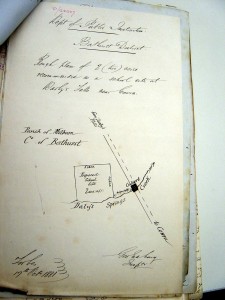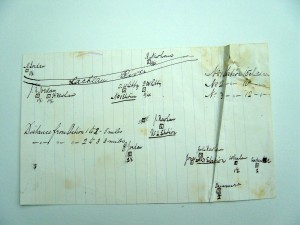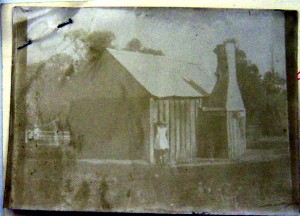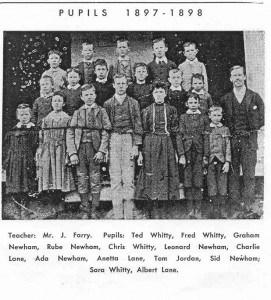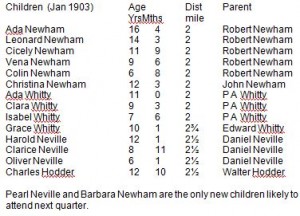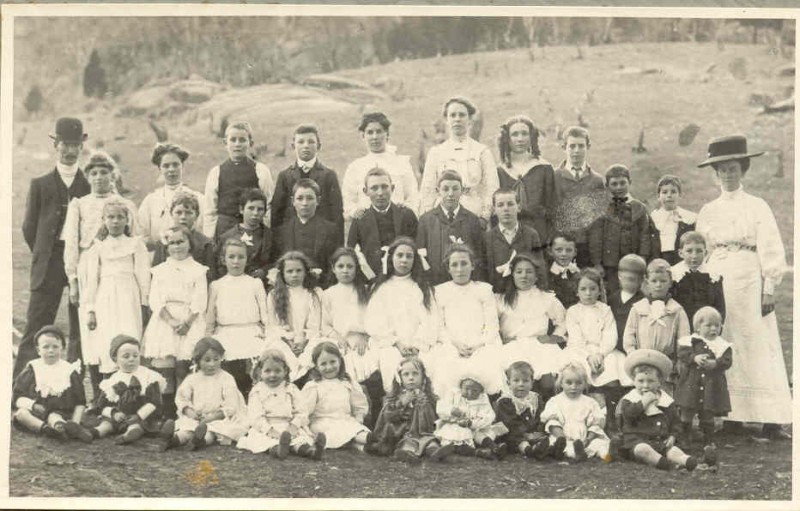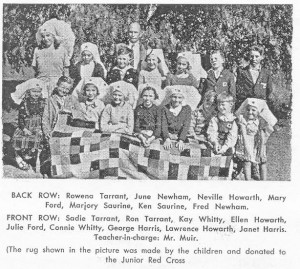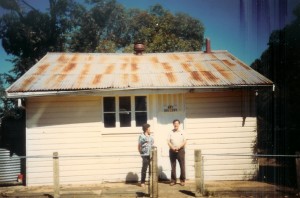Early Local Schooling 1830s, 1840s..
A small school for his children and those of his employees was established by my great great grandfather, Edmund Markham (1802-1866) -an early 1830s settler in the Darbys Falls area. The school was set up on on his property ‘Spring Vale’ on Milburn Creek, near its junction with the Lachlan River, in the early 1840s, when, according to his great grandson, my uncle Aubrey Murray, he employed two teachers – Hanley and Winton, about whom nothing more is known. Thomas O’Shaughnessy Jr wrote in his diary that, in 1843 when he was eight years old, he:
“ ….used to walk three miles to school to Spring Vale, Edmund Markham’s place, and back again in the evening except on Friday. I stayed all night for half Saturday school.”
This school was functioning before any facility in what was to become Cowra. In the late 1840s, according to W Duggan, who wrote in the Cowra Guardian on 11 November, 1905:
“The first teacher taught nine pupils in the back shed of the Fitzroy Hotel of which were:- William and Mary Duggan, William, John and Sarah Bus and two Conroys, the others I don’t remember. Soon after, the people had collected some money and had a school built on the flat, a two roomed wooden building with a bark roof. The school teacher’s name was Pearce. He didn’t remain long, and there was no school for two years after. The next school also broke up, and there was none till the year ’53. It was re-opened in ’53 by Lennox, who had about 26 scholars, some of which were:- William Duggan, Hannah, Elizabeth and Alick Middlemis, James, John, Catherine and Sarah Cummings, John, Hannah and Charlotte Tindal, Richard and Margaret Neville, Ellen, Daniel, Patrick and Mary Ann O’Brien, James and Jane Robinson, James Keys, and others. This school broke up and the first permanent school was opened by Madame Rigaut and husband between ’57 and ’60.”
The first bid for a Government school to service Cowra and the outlying areas was made on 16 April 1849, when six “Patrons”, including Edmund Markham – the other five other leading landholders being H.M. Fulton, (Mufton Park); W. Redfern Watt, (Bumbaldry); John Wood, (Brundah); R.N. McDiarmid, (Waugoola); James Sloan, (North Logan) – signed a submission to the Commissioners of the Board of Education seeking erection of a school in what was later gazetted as Cowra, stating that 158 children would attend, though about 40 children would need to board.
Bid for a Darbys Falls School.
As for the immediate Darbys Falls area, some fourteen miles outside Cowra on the road to Wyangala and Mt McDonald, it was not until some 20 years later, as the population increased, that bids were made to the NSW Government for a school. In the interests of genealogy researchers, as well as history, I have included, in addition to these notes, photographs and drawings, local names – parents and children. I would be happy to add to and/or clarify these or make amendments to the site on request.
My father, Neville Murray (1906 – 1980), who is in some of the photographs below, and whose father had died before he turned three, attended the school for much of his Primary School years at the beginning of the 20th Century, telling me often what a hard taskmaster the Headmaster, Mr Johnson, was. (My own experience was very short, perhaps a month or so in or about 1939, when we visited my grandmother, Margaret Murray, later Harris, nee Markham, at Darbys Falls where she was Postmistress for some 43 years. My only recollection as a four year old in the one room schoolhouse, was that of observing older children up the front of the room doing long division tables on the blackboard, murmuring to myself that I’d never be able to do anything like that!)
The earliest bid to have school established at the present day location of Darbys Falls, though more precisely identified at the time as “Daly’s Springs”, was made by John Whitty, giving his address as Darbys Falls (then located at the junction of Milburn Creek and the Lachlan), to the Minister of Education on July 18, 1880. Whitty pointed out that
“there are about thirty children from the age of four to about sixteen within about a four mile square….if there was a school erected here at a place known as Daly’s Springs, it would be a central place .”
He listed the interested parents and the number of 31 children – Richard Newham 3 children; James Newham 5; Patrick Jordan 5; John Jordan 5; Patrick Whitty 1; Thomas Whitty 4; John Whitty 4; Richard Carlin 1; and William Graham 3.
There is no record of a response, though it appears that some discussion was undertaken, and a reminder was sent in the following March when the community (represented by John Joseph Whitty, John Nicholas Jordan, Patrick Jordan, Patrick Whitty, and Nicholas Jordan) formally applied again, listing 27 children (20 boys, 7 girls; 3 C of E, 24 RC).
The full list of parents in these exchanges is not to be found but it included J N Jordan 1 1/2 miles from Darbys Falls (Mary Julia age 14, Patrick W 13, Nicholas 11, John 9 sarah 7); Thomas Whitty 2 miles (Rosanna 14, Patrick 11, John 7); Patrick Jordan 2 miles (Mary S 15, Nicholas 14, William 12, George 10); and Patrick Whitty 2 miles (Mary 5, Ann 4.)
In May 1881 J N Jordan again sought a reply. Inspector George E Long of Bathurst reviewed the bid, making a number of observations on 19 October 1881:
- The population of the school district was about 35 including adults and children;
- The applicants are agriculturists, and small graziers, occupying land obtained by bona fide conditional purchase;
- The nearest school is at Milburn Creek which is about 8 miles away;
- Number likely to be enrolled – 20 boys and 8 girls;
- A suitable site of 12 (sic) acres has, in view of future educational requirements of the place, been selected;
- The population of the district is too small and too scattered to afford the attendance necessary for the maintenance of a Public School attendance. I therefore advise that the application be declined; and
- There is however some probability that additional settlement may take place, and I therefore recommend that in view of possible future educational requirements that steps be taken for the acquisition of the land described.
Inspector Long further reported that the number of children being about 28, it was not possible to establish a school. However he pointed out to the applicants that they should claim provisional aid, available so long as they provided a suitable building and sufficient school furniture.
At the same time, Long recommended that land be set aside for a future school and provided a drawing identifying a 2 acre site on the Darbys Falls/Cowra Road. On this land, local parents commenced to build school premises. John Jordan, Harry Newham and Bill Jerome built with slab walls and a stringy bark roof a small schoolroom of 17 ½ feet by 12 ½ feet by 6 ½ feet. It became available in February 1883 but the Department found it difficult – mainly because of inadequate housing availability, to recruit a teacher for a “Provisional School”.
House to House School – September 1883 to November 1883
Consequently, a “House to House” School was approved,
Darbys Falls School Catchment Area for 37 students in 1883, prior to the establishment of the School.
with Mr Charles V C Hudson appointed teacher.
The arrangement was that he would teach 37 children
– 15 at Darbys Falls, 10 at Redbank, and 12 at Spring Creek,
– at each of the three stations a day in turn, approximately
equidistant. See Hudson’s map and a list of the children.
Place Children Age Parent J Newman’s Hannah Newham 14 James Newham “ Christopher Newham 12 “ “ Ellen Newham 10 “ “ Thomas Henry Newham 7 “ “ Charles Newham 5 “ Spring Creek Fredk Joseph Newham 11 John Newham “ Robert Newham 9 “ “ Alice Treasure 7 Lewis Treasure “ Edward Henry Treasure 5 “ “ Robert Carpenter 10 W Carpenter “ George Carpenter 8 “ “ Elizabeth Jones 13 Charles Jones “ Charles Jones 7 “ “ Margaret Jane Graham 13 William Graham “ Charles Alfred Graham 12 “ “ Vinson Mark Graham 10 “ “ Hannah Sophia Graham 6 “ Darbys Falls Nicholas Jordan 14 John N Jordan “ John Jordan 12 “ “ Sarah Jordan 10 “ “ Ann Jordan 8 “ “ Mary Whitty 7 Patrick Whitty “ Ann Whitty 5 “ “ John Whitty 10 Thomas Whitty “ Mary Whitty 8 “ “ Thomas Whitty 5 “ Red Bank Henrietta Newham 9 Henry Newham “ John Joseph Newham 7 “ “ Arthur Henry Newham 5 “ Darbys Falls David Newham 14 Richard Newham “ Francis Newham 12 “ “ George Newham 9 “ “ Rosetta Newham 5 “ “ Patrick Whitty 14 Thomas Whitty “ William Jordan 13 N(?) Jordan Milburn Creek George Jordan 18 P Jordan “ Lucy Jordan 8 “ Provisional School – November 1883 to June 1884
With the enrolment increasing, a “Provisional School”[1] was established on 1 November 1883, and by early in the next year enrolment had increased to 38..
Public School – June 1884 – November 1903
The original Darbys Falls Public School, built by the community in 1883 and sold to Sydney Newham for £3.10.0 in May 1906
In view of the number of full time pupils – 39 – the school was upgraded to a “Public School”. Mr C V C Hudson, though apparently not yet qualified to be a full teacher at a Public School, was highly regarded by his superiors and was appointed to continue in his role.The “community built” building was now “…too small, and not weathertight, and prejudiced to the health of the children”, claimed a successful petition from the parents. Consequently, a contract was let in September 1884 to Henry Francis of Cowra to build and furnish a new wooden building, 50% larger than the old school, (being 22ft x 14 x 9) for £198.0.0.
Later, some parents (successfully) petitioned the “Minister of Public Instruction” in October 1885
“…….that you will have the school ground fenced as the children who ride to school are greatly inconvenienced by not having a proper place to keep their horses.”
The parents who signed, all giving their address as Darbys Falls, were John Whitty, James Newham, H J Newham, J N Jordan, Patrick Whitty, Thomas Whitty, Richard Newham, and Catherine Carlin.
In considering the request, the Inspector (Mr Long) noted in November 1885 that
….the population in the vicinity of Darbys Falls is very sparse, and many children ride to school. A paddock for their horses would a great convenience. The school has an enrolment of 34. A new wooden building was provided for the school some ten months ago, at a cost of £190, for which the fence applied for will be a protection.”
P W Jordan was contracted to build the fence around the two acre site at a cost of some £30.
In the late 1880s, early 1890s there were serious outbreaks of Typhoid Fever and Diptheria. There were many contemporary Cowra Free Press accounts of the typhoid problems. In 1889 John Nicholas Jordan (1833-1917) wrote to the Minister asking that the school be closed temporarily due to the typhoid fever outbreak:
“…..there has been some fifteen cases of sickness in the locality within the last five or six weeks, of which number, four has (sic) proved fatal and some five or six now are down dangerously ill. Up to the last few days our local doctors could not or did not give the malady in question a name. Some two or three parties then called in Dr Healy from Young who, upon seeing two or three of the parties now being ill, at once pronounced the malady to be Typhoid Fever. I wish most respectfully to draw your attention to the fact that in two of the houses where there is at least one case of typhoid in each, there are two or more children from those places attending the Public School at Darbys Falls.
And that in view of the foregoing facts that you will cause inquiry into the matter with a view to closing the school in question (for the duration).
In 1898, the Neila Creek school closed and additional students attended the Darbys Falls School. Many came on horseback and additional fencing was provided to keep their horses from the immediate school grounds. The schoolmaster noted that on some days there were ten horses to be accommodated.
In 1899, the school closed for some months because of the unavailability of a teacher , the only married accommodation being available at Mt McDonald. The families petitioned the Government to reopen, stating that there were in the area some 21 children of the following families – Robert Newham (4 children), Edward Markham (3), Patrick Whitty (2), Thomas Whitty (2)
In December 1902, the low enrolment of fourteen (down from 34 in 1885) led the Inspector to review a list of students [below] and consider closing the school. The parents petitioned to keep it open, with a response along the lines that
“….the question of closing the school will be considered unless the requisite average is secured for the March quarter.”
In 1909, Thomas Markham, seeking Government agreement to convert the school from “Provisional” to full time, stated that there were thirteen children at the school.
Markham’s petition was successful and Mr Charles Johnson was appointed Principal, remaining for thirteen years, during which time a school residence was built. Further, a new school building was erected in 1911, necessary given the increased enrolment. When Mr Johnson took charge in May 1910 it had been a “Provisional” School with an enrolment of sixteen. He found that there some children who did not attend, but could, though living some considerable distance from it. He visited their parents and successfully encouraged them. So much so that in 1914 he noted that two children travel over 8 miles and another two, six miles to the school. In the same year he reported that four pupils over 15 attended the school. Rabbit trapping was the cause of some boys remaining away from school. He succeeded in getting these boys to attend school regularly.
Darbys Falls School picnic ca. 1912. BACK ROW. L to R: Headmaster Chas Johnson, Clare Howarth, Liz Whitty, Clem Newham, Les Whitty, Emmie Newham, Clara Whitty, Shore girl (not at school) Neville Ward, _____, Walter Newham, Mrs Chas Johnson. NEXT ROW: Maudie Howarth, Aubrey Murray, Herb Newham, Frank Ward, Eric Ward, Tom Markham, ____(may be Jock Ward), Jim (Jumbo) Markham. NEXT ROW: Rosie Markham, Nell Murray, Vena Newham, Edie Hickey, Maggie Newham, Molly Markham, Eileen Markham, Beryl Ward, Neville Murray, ____(perhaps Eden Whitty). NEXT ROW: Greg Jordan, Jack Jordan, Mary Markham, Vera Whitty, Millice Whitty, Lucy Newham, Ollie Jordan, Clarrie Markham, Nell Markham, Clive Markham.
Three years later, Mr Johnson, seeking to contest a possible decision to downgrade the school and appoint him elsewhere, wrote to the Inspector of Schools on 13 February 1914 (his full letter is here) as follows:
“I succeeded in getting the co-operation of the parents (after much talking and explaining) with the result that the equipment of the school is almost complete, being purchased from funds raised by school concerts and picnics. Included in the equipment is a library of over 80 volumes and periodicals, also a sewing machine. The parents have promised to supply me with sufficient wire netting for the fence I have asked to have erected, also to build a bridge across the creek which runs between the playground and the road.
The school ground is now the beauty spot of the locality. One of the first things I did after I came here was to make a vegetable and flower garden, which have been improved each year. To do this I had to take out 16 large box trees, split posts and erect a fence round the garden.
This garden has been the means of the boys starting both vegetable and flower gardens at their own homes. Last Cowra Show we obtained first prizes for vegetables and flowers. To carry on the gardening successfully I dug a well and purchased a pump and piping with funds raised by a concert. As the well is 8 chains from the garden the cost of the piping was considerable. I also put down a tennis court and cricket ground for the children and have taught them how to play the games. My wife also takes a keen interest in the girls and has taught them sewing, cookery, jam making, fruit preserving, work in plaster of paris and various others.”
Johnson’s bid to remain was strongly supported by the parents, evidenced in the following letter, written on 19 February 1914 to the Inspector of Schools in Young:
“We, the undersigned parents of children attending the Public School, having heard it is likely our teacher, Mr Johnson, is to be removed, we would therefore respectfully ask that his proposed removal be reconsidered, as we are more than satisfied with the progression our children have made under this teacher..
Signed by parents:Nicholas Markham, Grazier and Saw Miller, Darbys Falls,; John T Ward, Commercial Traveller; James Markham, Farmer; Mrs Margaret Murray, Postmistress; Hugh Newham, Grazier; H J Taylor, Carpenter, T Markham, Farmer, Darbys Falls, E Markham, Painter, Francis Newham, Parent. “
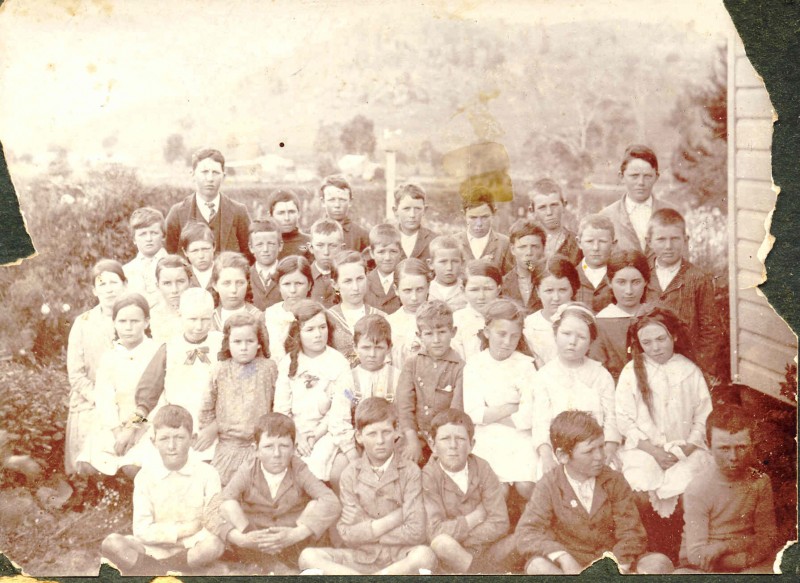
Darbys Falls Public School Students Ca. 1916 FRONT ROW: L to R: Jim Murray, Clive Markham, _____, Clarrie Markham, Eden Whitty, Jack Jordan. SECOND ROW: Vena Newham, Sylvia Neville, _ Kershaw, Amy Kershaw, ____, Harold Oliver, ____, Jean Jordan, __ Newham. THIRD ROW: Lucy Wass, Nell Markham, Vera Whitty, Ruby Neville, Millice Whitty, _____, Ena Markham, ____, Mary Markham. FOURTH ROW: Eric Newham, _____, _____, Percy Newham.
An indication of support for Mr Johnson (who was not Catholic) was a statement by the Catholic Rev Fr O’Kennedy from the pulpit around that time. He told the congregation:
“that they were most fortunate to have such good people in their midst as the teacher and his wife and advised them to keep their children at school regularly,and do their best to keep them in Darbys Falls.”
On 14 August 1919 Mr Johnson applied for the appointment of an Assistant Teacher.
I have the honour to inform you that the enrolment at this school has increased from 53 to 60 and the average attendance from 46 to 52, and ask that an assistant teacher be appointed here. The pupils are classed: Class I 15; Class II 8; Class III 7; Class IV 8; Class V 7; Class VI 15. There are also seven children of school age not now attending but whose parents have promised to send them.
Margin note: Recommended. Accommodation for a lady assistant can be obtained at the residence of Mrs C Johnson.
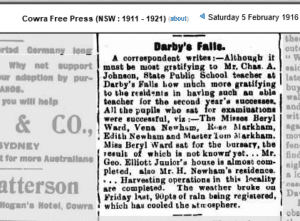 The first Assistant Teacher was a nineteen year old Miss Thelma Barnes who transferred in mid-1921 to be Teacher in Charge at the Wyangala Public School; and in the next year married my father’s older brother Aubrey Murray.
The first Assistant Teacher was a nineteen year old Miss Thelma Barnes who transferred in mid-1921 to be Teacher in Charge at the Wyangala Public School; and in the next year married my father’s older brother Aubrey Murray.
With no successor for the balance of the year, parents petitioned the Minister in December 1921 for a replacement:
“We the undersigned parents of Darbys Falls, beg to petition you to have an Assistant Teacher appointed to the Public school at Darbys Falls. In July last the assistant teacher was removed and no one appointed in her place. The enrolment at present is 56 and the average daily attendance this quarter is 49. We consider that it is impossible for one teacher to do justice to this number of children divided into six classes.
Trusting this matter will have your earnest consideration,we are: Thomas Markham Jr, Secretary, Progress Association; and Oswald Ford, James Markham; B M Ward; M Harris; N J Markham; Geo Elliott; J E Jordan; A C Waters; A A Wass; H W Oliver; W S Oliver; W J Carpenter; T J Whitty; H Whitty; J J Anthony; H J Taylor; Joseph Moss; James Horsfall; Daniel Neville; Sydney Newham; C Howarth; A Vaughan.
A replacement was duly provided. The full list, assembled by Mr W E Muir, Teacher from 1948-1965, herewith:
Mr C V C Hudson 1884; Mr W Levey 1885; Mr Greville 1886 – 1891; Mrs McBrider 1891 – 1895; Mrs J Farry 1895 – 1899; Mr Broady 1899; Mr Shumack 1900; Mr A R Bate 1901 – 1905; Mrs P Laughlin 1905 – 1908; Mr J Davies 1908 – 1910; Mr Chas Johnson 1910 – 1923; Mr Giovanelli 1922; Mr Graham 1923 – 1928; Mr H Hyde 1928; Mr E Warren 1929 – 1937; Mr S Rodwell 1937 – 1942; Mr R O Pryor 1942 – 1948; Mr W E Muir 1948 – 1965; Mr T Hunter 1965 – 1971; and Mr N Wheatley 1971. The assistant teachers were Miss Thelma Barnes 1919 – 1921; Miss B James 1921 – 1922; and Miss V Swan 1922.
[NOTE: “Darbys Falls : A Bush Village” by Frank and Carmel (Hudson) Connor in 1997; “Earliest Memories of Darbys Falls” by Gordon Elliott in 1999 and “70th Anniversary of the Opening of Darbys Falls Public School 1884-1954” published in ‘Eagle Eye’ of the Cowra Family History Group in March 1987 ;and particularly Teacher Mr W E Muir who collected and collated information for the 70th anniversary of the school’s opening. All these important sources supplement family myths and facts about local education arrangements which have been handed down through the years. I have added to family notes from these documents as well as from NSW Archives Office Records.]
- An elementary school which first emerged in 1867. A Provisional School could be established in areas where at least fifteen children, but fewer than the twenty five required for a Public School, could be expected to attend. Parents provided the building and furniture, while the Department provided the teacher and paid for books and equipment.↵
